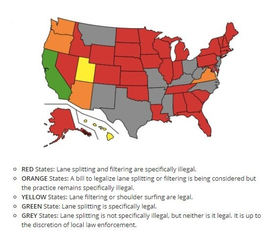I am curious to learn whether the inclusion of research from New South Wales, Victoria, and Queensland in Australia, as well as European research, added to several studies from California will contribute effectively to moving legislation to allow a form of lane-filtering here in Washington state. It is from those locations that research has demonstrated that the practice of allowing motorcyclists to split lanes, or move between lanes on surface streets to be safer for motorcyclists, while also reducing the overall commute times for all highway users. Both techniques are currently legal in California, with lane-filtering legal in Utah. In Europe, and many other locations in the world, it is not only legal but the expected behavior of motorcyclists. In twelve US states, the practice is in a grey area, neither legal nor illegal as it is not codified at all in state law. In Washington state, the main opponents have been the Washington State Patrol, who simply repeats testimony in legislative hearings that they find it to be an unsafe practice. Partially because Washington drivers are not used to the idea.
Be part of the movement!
Welcome to the community for those who value free speech, evidence and civil discourse.Create your free account
3 comments
Feel free to reply to any comment by clicking the "Reply" button.I had an uncle from Canada come visit Cebu decades back. When he saw how the drivers here drove in traffic, he said he'd never want to drive here.
As a motorcyclist from Australia, you might want to do this research in Washington by putting your politicians on a boat and sinking it.
It's just a thought.
I live in the other Washington the state ,not DC, that could be an option for us also.
@Cancelled, With the Progressive Governor and Majority in both chambers of the state legislature, that might be a good experiment. Especially since our (Washington state) Capitol sit atop a hill over looking the sea.
Lane splitting increases the chance of accident. Nuff said.
Actually, the data from over 40 years of research tend to dispute that. Unless you call weaving between vehicles at high speed lane-splitting. That's not lane-splitting, that's just racing. Which would be illegal under virtually all lane-splitting laws on the books, or being offered.
@8BallBrian, as someone trained by the Center For Transportation Safety, I dispute your assertion, and would like to know your sources. You said “studies” over 40 years. I have seen one study that said the opposite.
Common sense should tell you that if you travel at any significant speed difference with other traffic, particularly through narrow passages and large differences in vehicle mass, mishaps are more likely and consequences are high.
@TimTuolomne I would refer you to the 1981 USC study on "MOTORCYCLE ACCIDENT CAUSE FACTORS AND IDENTIFICATION OF COUNTERMEASURES" by HH Hurt Jr, which showed that lane-splitting motorcycles were under-represented, and accounted for only 0.6% of crashes while they accounted for 60% of observed motorcycles. Also, the 2009 Motorcycle Accident In-Depth Study showed a 0.4% lane-splitting-related crash percentage. In 2011 Dr. JV Ouellete compared the findings from the "Hurt Report" and his own 2011 study and found no significant difference in findings between the two. Both the 2014 & 2015 UC Berkeley studies showed that lane-splitting when performed following the California Highway Patrol guidelines resulted in significantly lower rates of crashes, and less significant injuries, and lower fatality rates than non-lane-splitting motorcyclists.
Your point on "significant speed difference" is key. From the "Hurt Report" to now, when the speed differential exceeds 10-15 mph, the risk of a crash is low. It is not until the speed differential increases significantly above that point, say 20-30mph (or more) then the risk increases. But at that point, it is no longer considered lane-splitting, but racing. From Europe to the US, and on to Australia, lane-splitting laws require the low 10-15 mph speed differential. It may seem counter-intuitive, but the data consistently shows very similar findings across decades and continents. Even the National Highway Traffic Safety Administration has published statements that lane-splitting should be further studied because; "it offers a means of reducing
congestion in addition to possible safety benefits. It is widely used in many other countries."
Be part of the movement!
Welcome to the community for those who value free speech, evidence and civil discourse.Create your free account
Share this post
Categories
Slug does not evaluate or guarantee the accuracy of any content. Read full disclaimer.








